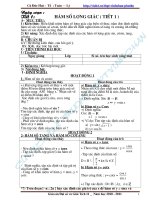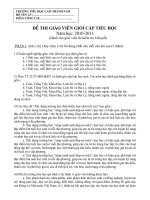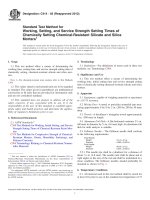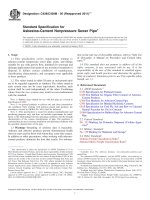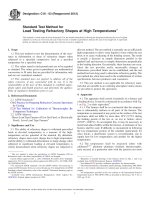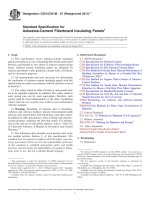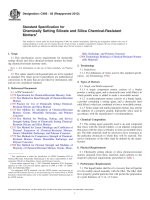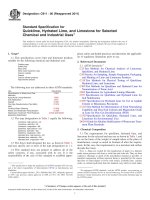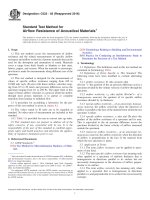Astm c 1297 03 (2011)
Bạn đang xem bản rút gọn của tài liệu. Xem và tải ngay bản đầy đủ của tài liệu tại đây (148.36 KB, 6 trang )
Designation: C1297 − 03 (Reapproved 2011)
Standard Guide for
Qualification of Laboratory Analysts for the Analysis of
Nuclear Fuel Cycle Materials1
This standard is issued under the fixed designation C1297; the number immediately following the designation indicates the year of
original adoption or, in the case of revision, the year of last revision. A number in parentheses indicates the year of last reapproval. A
superscript epsilon (´) indicates an editorial change since the last revision or reapproval.
C1210 Guide for Establishing a Measurement System Quality Control Program for Analytical Chemistry Laboratories Within the Nuclear Industry
C1215 Guide for Preparing and Interpreting Precision and
Bias Statements in Test Method Standards Used in the
Nuclear Industry
2.2 ISO Standard:
ISO Guide 30 Terms and Definitions Used in Connection
with Reference Materials3
1. Scope
1.1 This guide covers the qualification of analysts to perform chemical analysis or physical measurements of nuclear
fuel cycle materials. The guidance is general in that it is
applicable to all analytical methods, but must be applied
method by method. Also, the guidance is general in that it may
be applied to initial qualification or requalification.
1.2 The guidance is provided in the following sections:
Qualification Considerations
Demonstration Process
Statistical Tests
Section
4
5
6
3. Significance and Use
3.1 This is one of a series of guides designed to provide
guidance for implementing activities that meet the requirements of a sound laboratory quality assurance program. The
first of these, Guide C1009, is an umbrella guide that provides
general criteria for ensuring the quality of analytical laboratory
data. Other guides provide expanded criteria in various areas
affecting quality, producing a comprehensive set of criteria for
controlling data quality. The approach to ensuring the quality
of analytical measurements described in these guides is depicted in Fig. 1.
1.3 This standard does not apply to maintaining qualification during routine use of a method. Maintaining qualification
is included in Guide C1210.
1.4 This standard does not purport to address all of the
safety concerns, if any, associated with its use. It is the
responsibility of the user of this standard to establish appropriate safety and health practices and determine the applicability of regulatory limitations prior to use.
2. Referenced Documents
3.2 The training and qualification of analysts is one of the
elements of laboratory quality assurance presented in Guide
C1009, which provides some general criteria regarding qualification. This guide expands on those criteria to provide more
comprehensive guidance for qualifying analysts. As indicated
in Guide C1009, the qualification process can vary in approach; this guide provides one such approach.
2
2.1 ASTM Standards:
C1009 Guide for Establishing and Maintaining a Quality
Assurance Program for Analytical Laboratories Within the
Nuclear Industry
C1068 Guide for Qualification of Measurement Methods by
a Laboratory Within the Nuclear Industry
C1128 Guide for Preparation of Working Reference Materials for Use in Analysis of Nuclear Fuel Cycle Materials
C1156 Guide for Establishing Calibration for a Measurement Method Used to Analyze Nuclear Fuel Cycle Materials
3.3 This guide describes an approach to analyst qualification
that is designed to be used in conjunction with a rigorous
program for the qualification and control of the analytical
measurement system. This requires an existing data base which
defines the characteristics (precision and bias) of the system in
routine use. The initial development of this data base is
described in Guide C1068. The process described here is
intended only to qualify analysts when such a data base exists
and the method is in control.
1
This guide is under the jurisdiction of ASTM Committee C26 on Nuclear Fuel
Cycleand is the direct responsibility of Subcommittee C26.08 on Quality Assurance,
Statistical Applications, and Reference Materials.
Current edition approved June 1, 2011. Published June 2011. Originally
approved in 1995. Last previous edition approved in 2003 as C1297 - 03. DOI:
10.1520/C1297-03R11.
2
For referenced ASTM standards, visit the ASTM website, www.astm.org, or
contact ASTM Customer Service at For Annual Book of ASTM
Standards volume information, refer to the standard’s Document Summary page on
the ASTM website.
3.4 The qualification activities described in this guide assume that the analyst is already proficient in general laboratory
3
Available from American National Standards Institute (ANSI), 25 W. 43rd St.,
4th Floor, New York, NY 10036, .
Copyright © ASTM International, 100 Barr Harbor Drive, PO Box C700, West Conshohocken, PA 19428-2959. United States
1
C1297 − 03 (2011)
processes, has the potential for undetected errors. There are two types of
errors that occur. One is to fail an individual who should have been
determined to be qualified. The other error is to pass an individual who
should not have been determined to be qualified. The potential for these
errors to occur and the potential consequences to the laboratory should be
carefully considered when determining the laboratory’s qualification
methodology. A statistical approach includes choosing the significance
level at which the determination of qualification will be made. This
produces a quantitative value of the two possible risks. This is described
further in Appendix X1.
5. Demonstration Process
5.1 The suggested approach to practical demonstration for
analyst qualification that is described in the remainder of this
guide involves a comparison of the performance of the analyst
with the performance of all qualified analysts on a particular
analytical method. The performance is measured by the analysis of reference materials (see ISO Guide 30) and comparison
of the results to the data base for the analytical method. This
approach requires a data base that describes method performance. The comparison described in this guide is statistical in
nature and therefore statisticians should be involved early on in
the process of defining qualification. Other types of comparisons may serve to qualify equally well; however, such comparisons are not addressed in this guide. If used, they should be
defined and documented.
FIG. 1 Quality Assurance of Analytical Laboratory Data
operations. The training or other activities that developed this
proficiency are not covered in this guide.
5.2 The data base for a given analytical method is generated
by all qualified analysts who run reference material samples on
an established schedule or frequency. The data base is used to
establish the bias and precision of the method as routinely used
in the laboratory. The data base is established through a
measurement control program as presented in Guide C1210.
For a new method, a data base should be established according
to Guide C1068 and the analyst should be qualified against that
data base.
3.5 This guide describes a basic approach and principles for
the qualification of laboratory analysts. Users are cautioned to
ensure that the qualification program implemented meets the
needs and requirements of their laboratory.
4. Qualification Considerations
4.1 When a qualification program is being established,
consideration should be given to analyst selection criteria, the
training program, and practical demonstration. The criteria that
govern when qualification is achieved should be documented
along with methods for determining the knowledge and skill of
the analyst.
4.1.1 Analyst selection should be based on established
criteria that are related to the complexity of the method that
analysts are expected to perform. Criteria should include the
minimum education required, any prerequisite training, and the
overall experience required. The selection criteria should be
defined and documented.
4.1.2 The method-specific analyst training program should
be an established program with a prescribed training procedure. Some mechanism such as an oral or written test should be
used to allow an analyst to demonstrate knowledge and
understanding of the chemical, physical, instrumental, and
mathematical concepts used to execute the method. It is
advisable to monitor progress during training to ensure that the
analyst has a reasonable chance of passing the qualification
test.
4.1.3 The practical demonstration of the analyst’s ability to
generate results with the analytical method should be compared
to established criteria. The comparison criteria should be
defined and documented.
5.3 If changes in a method occur or changes in the execution
of a method occur that render the existing data base representation of the method questionable, the qualification of analysts
should be suspended until the data base is verified or a new
data base is generated. When a new data base is generated, the
old data base should be archived (retained for future reference)
as a part of the documentation of the laboratory quality
assurance program.
5.4 A predetermined number of reference material samples
should be selected for the analyst after training has been
completed. The analyst should analyze the samples over
several days, and not in a single session, to simulate more
realistically the conditions under which the data base was
established.
5.5 Since the samples may be at different concentration
levels, the analyst’s demonstration results are normalized using
established parameters from the existing data base for each
control standard. The normalized data are used to test for
conformity to the data base. Statistical tests for the statistical
distribution (normality) as well as precision and bias are
suggested in Section 6. These terms are described in Guide
C1215.
5.6 If the results of all three tests are satisfactory, the analyst
is qualified on that method. If the analyst does not qualify,
NOTE 1—The qualification of analysts, like many other laboratory
2
C1297 − 03 (2011)
retraining should be required before being allowed to retest for
qualification. The analyst should be given a different set of
reference material samples each time retesting is allowed to
maintain the independence of successive tries. That will allow
the same statistical tests to be used on each set of results. See
Fig. 2 for a schematic of the qualification process.
6.2 The analysts’s data set is first tested for statistical
normality. If normality is rejected, the data set is rejected and
the analyst is determined to have failed the qualification test. If
the data set is accepted as normally distributed, bias and
precision tests may be performed.
6.3 If these statistical tests indicate that the analyst’s data set
exhibits bias and precision estimates that are within those of
the established data base, the analyst is determined to be
qualified. If the precision or bias estimates, or both, are not
acceptable, the data set is rejected and the analysts is determined to have failed the qualification test.
6. Statistical Tests
6.1 There are a number of statistical procedures appropriate
for performing the statistical tests on the analyst’s demonstration data set to determine qualification. The procedures detailed in Appendix X2 are suggested since they have proven to
be useful. Further information about these procedures is
provided by Snedecor and Cochran4 and by NUREG/CR4604.5
6.4 Examples of statistical tests are presented in Appendix
X2.
7. Keywords
4
Snedecor, G.W., and Cochran, W.G., Statistical Methods, 8th Ed., Iowa State
University Press, Ames, Iowa, 1989.
5
NUREG/CR-4604, Statistical Methods for Nuclear Material Management,
U.S. Nuclear Regulatory Commission, Washington, DC, 1988.
7.1 analyst qualification; measurement(s); quality assurance; reference materials
3
C1297 − 03 (2011)
FIG. 2 Steps in the Analyst Qualification Process
APPENDIXES
(Nonmandatory Information)
X1. STATISTICAL CONSIDERATIONS
tion tests so that only the risk of rejecting a qualified analyst
may be adequately controlled by an appropriately small level
of significance.
X1.1 The significance level, α, for a statistical test is set
depending on the desired risk of rejecting a qualified analyst.
The smaller the significance level, the smaller the chance that
a qualified analyst will be rejected (Type I error). For example,
if the significance level is 0.10, then there is a one in ten chance
that a qualified analyst will fail the test. However, by using a
small α, the chance of accepting an unqualified analyst is large
(Type II error). Thus there is a trade-off between accepting an
unqualified analyst and rejecting a qualified one. Both types of
errors can be controlled at desirable low levels by requiring a
sufficiently large number of demonstration tests.4,5 Practical
limitations usually restrict the available number of demonstra-
X1.2 For multiple statistical tests, another factor that should
be considered when selecting the significance level of each test
is the overall significance level. For example, the overall
significance level for three independent tests would be
α' = 1 − (1 − α)4. Therefore, if the significance level of each
test was 0.05, the overall significance level would be 0.143. In
other words, the chance of a qualified analyst failing any one or
more of three independent statistical tests when each test has a
significance level of 0.05 would be 14.3 %.
4
C1297 − 03 (2011)
X2. SUGGESTED STATISTICAL TESTS
X2.3.1 Problem Statement—Test whether the standardized
demonstration results have a mean different from the mean of
the standard normal distribution.
X2.1 TEST 1—Test for Normality:
X2.1.1 Problem Statement—Test whether the demonstration
data set is normally distributed.
H o :µ 5 0 H a :µfi0
NOTE X2.1—This test assumes that the data base itself is normally
distributed.
Let,
xi 2 µi
Yi 5
σi
n
Y¯ 5
(
i51
n
2
s 5
(
~Y
i51
X2.3.2 Test Statistic:
Z5
(X2.1)
Yi
n
2 Y¯ !
n21
2
X2.3.3 Acceptance Region—Use standard normal tables to
determine the acceptance region for a desired level of
significance.4,5
X2.3.4 The following examples provide data and test results
for actual qualification at a particular laboratory.
X2.4 Example 1:
Method: 67015
Demonstration
Result
0.62616
6.04147
1.74910
3.32222
1.79410
3.32106
5.95575
5.99493
0.60847
(X2.4)
where:
k
b5
( a ~Y
i51
i
n2111
2 Y i!
(X2.5)
Yi are sorted in ascending order,
k = n ⁄2, rounded down, and
ai are the Shapiro-Wilks coefficients.4,5
A
X2.2 TEST 2—Testing the Variance (Precision):
X2.2.1 Problem Statement—Test whether the standardized
demonstration results have a variance different from the
variance of a standard normal distribution.
σ
2
From data base.
X2.5 Example 2:
(X2.6)
Method: 57171
Demonstration
Result
169.60333
170.62016
990.31934
178.85460
579.69067
588.37824
32.99648
997.59399
35.35918
X2.2.2 Test Statistic:
~n 2 1!s 2
Analyst: RRR
Standardized
Result
−0.002
−1.193
−2.852
−1.184
−0.628
−1.219
−2.221
−1.751
−1.050
X2.4.2 Tests indicate an overall conclusion that Analyst
RRR FAILED.
H a :σ 2 fi1
X 25
Analyst Testing Form
Log Number: 050416
Known Standard
Known
DeviationA
MeanA
0.62620
0.01689
6.14100
0.08341
1.80680
0.02023
3.36210
0.03368
1.80680
0.02023
3.36210
0.03368
6.14100
0.08341
6.14100
0.08341
0.62620
0.01689
X2.4.1 All tests performed at the 0.05 level of significance:
X2.4.1.1 The data PASSED the normality test (ShapiroWilks value = 0.976).
X2.4.1.2 The calculated chi-square value for precision of
5.673 is not significant (PASSED).
X2.4.1.3 The calculated Z-value for bias of −4.790 is significant (FAILED).
X2.1.3 Acceptance Region—Use Shapiro-Wilks tables to
determine the acceptance region for a desired level of
significance.4,5
H o :σ 2 5 1
(X2.9)
(X2.3)
X2.1.2 Test statistic:
b2
~n 2 1!s
σ/ =n
where:
µ = 0 and σ = 1.
where:
xi = theith demonstration result,
µi = the known mean associated with theith reference material sample in the data base, and
σi = the known standard deviation associated with theith
reference material sample in the data base, and n is the
number of demonstration results.
W5
Y¯ 2 µ
(X2.2)
2
i
(X2.8)
(X2.7)
where:
σ 2 = 1.
X2.2.3 Acceptance Region—Use chi-square tables to determine the acceptance region for a desired level of significance
and n−1 degrees of freedom.4,5
A
Analyst Testing Form
Log Number: 04199
Known
Known Standard
MeanA
DeviationA
167.66600
5.27760
167.66600
5.27760
989.90796
15.72945
167.66600
5.27760
571.09302
15.78838
571.09302
15.78838
37.75880
4.71521
989.90796
15.72945
37.75880
4.71521
Analyst: QQQ
Standardized
Result
0.367
0.560
0.026
2.120
0.545
1.095
−1.010
0.489
−0.513
From data base.
X2.5.1 All tests performed at the 0.05 level of significance:
X2.3 TEST 3—Testing the Mean (Bias):
5
C1297 − 03 (2011)
X2.5.1.1 The data PASSED the normality test (ShapiroWilks value = 0.962).
X2.5.1.2 The calculated chi-square value for precision of
7.581 is not significant (PASSED).
X2.5.1.3 The calculated Z-value for bias of 1.822 is not
significant (PASSED).
X2.5.2 Tests indicate an overall conclusion that Analyst
QQQ PASSED.
ASTM International takes no position respecting the validity of any patent rights asserted in connection with any item mentioned
in this standard. Users of this standard are expressly advised that determination of the validity of any such patent rights, and the risk
of infringement of such rights, are entirely their own responsibility.
This standard is subject to revision at any time by the responsible technical committee and must be reviewed every five years and
if not revised, either reapproved or withdrawn. Your comments are invited either for revision of this standard or for additional standards
and should be addressed to ASTM International Headquarters. Your comments will receive careful consideration at a meeting of the
responsible technical committee, which you may attend. If you feel that your comments have not received a fair hearing you should
make your views known to the ASTM Committee on Standards, at the address shown below.
This standard is copyrighted by ASTM International, 100 Barr Harbor Drive, PO Box C700, West Conshohocken, PA 19428-2959,
United States. Individual reprints (single or multiple copies) of this standard may be obtained by contacting ASTM at the above
address or at 610-832-9585 (phone), 610-832-9555 (fax), or (e-mail); or through the ASTM website
(www.astm.org). Permission rights to photocopy the standard may also be secured from the Copyright Clearance Center, 222
Rosewood Drive, Danvers, MA 01923, Tel: (978) 646-2600; />
6
